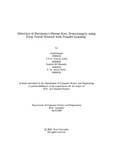| dc.contributor.advisor | Parvez, Mohammad Zavid | |
| dc.contributor.advisor | Reza, Md. Tanzim | |
| dc.contributor.author | Asaduzzaman | |
| dc.contributor.author | Sakib, A.F.M. Nazmus | |
| dc.contributor.author | Shusmita, Sanjida Ali | |
| dc.contributor.author | Kabir, S. M. Ashraf | |
| dc.date.accessioned | 2021-06-01T03:47:21Z | |
| dc.date.available | 2021-06-01T03:47:21Z | |
| dc.date.copyright | 2020 | |
| dc.date.issued | 2020-04 | |
| dc.identifier.other | ID: 17101531 | |
| dc.identifier.other | ID: 16201005 | |
| dc.identifier.other | ID: 16301154 | |
| dc.identifier.other | ID: 16301034 | |
| dc.identifier.uri | http://hdl.handle.net/10361/14457 | |
| dc.description | This thesis is submitted in partial fulfillment of the requirements for the degree of Bachelor of Science in Computer Science and Engineering, 2020. | en_US |
| dc.description | Cataloged from PDF version of thesis. | |
| dc.description | Includes bibliographical references (pages 54-59). | |
| dc.description.abstract | Parkinson’s disease is a neurological condition that is dynamic and steadily influences the movement of the human body. It causes issues within the brain and slowly
increments time by time. Tremor is the major side effect of PD where the entire
body begins shaking. Besides, a person’s muscle may end up rigid or stiff and it
may happen any portion of his body. PD influences the central apprehensive system
which is happening because of the hardship of dopaminergic neurons brought about
in a neuro-degenerative incubation. It is grouped beneath advancement clutter as
patients who have PD appear with tremor, unyielding nature, postural shifts, and
lessen in unconstrained advancements. There is no particular diagnosis process for
PD. PD varies from one person to another person and the situation and history.
MRI, CT, ultrasound of the brain, PET scans are common imaging tests to figure
out this disease but these tests are not particularly effective. In this research, several
tests ran on two types of data group - control and PD affected people. The dataset
is collected from the Parkinson’s Progression Markers Initiative (PPMI) repository.
Then MRI slices are processed from selected data group into the CNN models. Three
CNN models are sent into this thesis work to extract features from the data group.
The CNN models are InceptionV3, VGG16 and VGG19. These models are used
in this research to compare and get better accuracy. Among these models VGG19
worked best in the dataset because the accuracy for VGG19 is 91.5% where VGG16
gives 88.5% and inceptionV3 gives 89.5% on detecting PD. | en_US |
| dc.description.statementofresponsibility | Asaduzzaman | |
| dc.description.statementofresponsibility | A.F.M. Nazmus Sakib | |
| dc.description.statementofresponsibility | Sanjida Ali Shusmita | |
| dc.description.statementofresponsibility | S. M. Ashraf Kabir | |
| dc.format.extent | 59 pages | |
| dc.language.iso | en_US | en_US |
| dc.publisher | Brac University | en_US |
| dc.rights | Brac University theses are protected by copyright. They may be viewed from this source for any purpose, but reproduction or distribution in any format is prohibited without written permission. | |
| dc.subject | Parkinson’s Disease (PD) | en_US |
| dc.subject | Neurological condition | en_US |
| dc.subject | Dopaminergic neurons | en_US |
| dc.subject | PPMI | en_US |
| dc.subject | MRI | en_US |
| dc.subject | CNN | en_US |
| dc.subject | Extract features | en_US |
| dc.subject | VGG3 | en_US |
| dc.subject | VGG16 | en_US |
| dc.subject | VGG19 | en_US |
| dc.title | Detection of Parkinson’s disease from Neuro-imagery using deep neural network with transfer learning | en_US |
| dc.type | Thesis | en_US |
| dc.contributor.department | Department of Computer Science and Engineering, Brac University | |
| dc.description.degree | B. Computer Science | |

